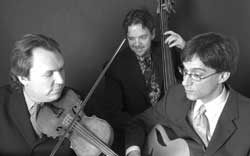 Mark O’Connor:
From Nashville to San Francisco, Musician Extraordinaire
Mark O’Connor:
From Nashville to San Francisco, Musician Extraordinaire
by Joan Baum, Ph.D.
Though Itzhak Perlman and Isaac
Stern have both lovingly referred to their violins as “fiddles,” Mark O’Connor
may have the world’s indisputable claim to the term.
By all accounts—professional and lay (The New York Times,
among numerous others, calling him “spectacular”)—O’Connor
is a superb fiddle player, whose performances and compositions
have been creating a sensation in the music world—on
stage and on CDs. “Fiddle Concerto No 1,” for example
(pointedly titled to embrace the compatibility between folk
and classical), is said to be the “most-performed modern
violin concerto.” Though his virtuoso work on the guitar
and the mandolin have also won wide praise, the “fiddle”—a.k.a.
violin—is O’Connor’s most abiding love, both
the word and the instrument. The “slangy, casual moniker,” he
says, keeps him conscious of the world of folk culture that
has prompted so much of his musicianship and that is explicitly
reflected in the names of some of his best-selling albums, “Appalachia
Waltz” and “Appalachian Journey,” which won
a Grammy in 2001. For five years running, Mark O’Connor
was Country Music Association’s Musician of the Year.
What is particularly remarkable
about this still not-as-well-known-as-he-should-be extraordinary
talent is his range: jazz, folk, classical, rock. He can
do traditional, he can do experimental, he can play acoustic,
he can do electric. He fiddles brilliantly and regularly
with the likes of Nadja Salerno-Sonnenberg, Yo-Yo Ma and
the double bassist Edgar Meyer, as well as with well known
rock and folk groups. Later this month his new album “In
Full Swing” will be released, and next month, February
2003, he’ll be at Lincoln Center playing with Wynton
Marsalis and vocalist Jane Monheit. But wait, there’s
even more to this astonishing young man who at 41 has already
covered more ground than an aggregate of musicians. Indeed,
Mark O’Connor
is an aggregate of musicians—record artist, educator,
arranger, music camp director (in Nashville and San Diego),
strings conference director (he prefers “fiddle gatherings”),
and of course, composer and performer. What unites all these
activities is the quality O’Connor brings to his work,
which has been called “distinctively American.”
No “crossover” artist, O’Connor is the first
to point out that he crossed over long ago when, at the age
of 7 he moved from guitar, his first instrument, playing classical
and flamenco, to the fiddle, when he was 11. He sees himself
as an “inclusive” musician. “Innovative” could
also apply, as well as “inspired.” His fertile
imagination seems to know no bounds. Ideas just come to him.
Thinking about 9/11 one day led to his composing a Folk Mass,
an a cappella work for the Gloriae dei Cantores singers from
New England, which will premiere at St. Thomas Church in the
City. Unlike most composers, he does not sit at the piano and
write. Everything, he says somewhat shyly, seems to originate
and develop in his head.
Though legend has it that O’Connor is largely self-taught,
he has had formal lessons on the violin, the guitar and mandolin.
He is also the first to credit the major influences in his
life. When talking about his mother, his tentative, somewhat
halting tenor noticeably shifts into animated mode. She was,
before she died of cancer when he was 20, the guiding light
of his life. No one played an instrument in his family, he
says, though he does remember that the stereo was always on
with classical music. In better days, his presents were ballroom
dancers, which may account for O’Connor’s attraction
to flamenco guitar when he was young. He also singles out the
great Texas fiddler, Benny Thomasson, and jazz guitar legend
Stephane Grappelli.
It is not just Mark O’Connor’s
music, however, that commands attention. It is his extraordinary
personal story, which includes the kind of grim childhood
and adolescence that one associates with 19th century novels.
Growing up poor, in a bleak Seattle backwater, lonely, solitary,
burdened prematurely with responsibilities at home and totally
ignored at school (when he was not being waylaid and beaten
up) for accomplishments that were already being reported
in the press, he came to feel that he had a gift that no
one wanted. When the occasional opportunity to perform did
come along, he and his mother were met with resistance and
mockery from high school administrators. At the time there
was not one musical instrument in the entire building, he
points out. Depressed, anxious, withdrawn, he decided at
the age of 17 to hit the road, a trail that led to Georgia
(where he played with The Dixie Dregs, a top rock fusion
group), to Nashville, to San Francisco, purposeful drifting
that with each turn brought him great admiration. His story
is one he tells for cathartic reasons, obviously, but also
perhaps as a cautionary tale and as a way of explaining his
views about music education.
He thinks that young people should expose themselves to playing
different kinds of
music and learning various instruments. Specialization, rigid
curricula, age-structured or mode-conditioned instruction are
not for him. He notes, incidentally, that his old high school
was completely rebuilt some years ago and underwent a total
curricular overhaul, including the institution of a music program.
Nonetheless, he laments the diminution of the culture of music
in America today, the lack of performance in homes. There is
just so much that schools can do or should do. When he was
a child, even the poorest would gather in rooms to sing and
play. Pianos were the rule not the exception. And then, of
course, reflecting on his unhappy childhood, Mark O’Connor
articulates a heartfelt belief not only in the healing power
of music but in its significance for a free society.#
More on this unusual
musician can be found on his website: www.markoconnor.com
